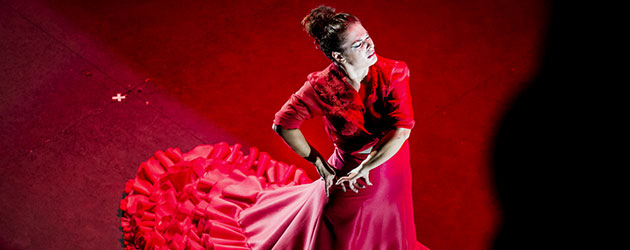Text: Sara Arguijo
Photos: Oscar Romero / La Bienal
Dance: Pastora Galván. Voice: Angelita Montoya, Jeromo Segura, La Tana. Guitar: Juan Requena. Percussion: José Carrasco. Accordion and zanfoña: José Manuel Vaquero. El Pájaro. Contrabajo: Álvaro Ramos. Teatro Lope de Vega ? Wednesday, September 28th, 2016
Pastora Galván: the Gypsy Queen
If people like Pastora Galván, it’s because of her natural grace, her earthiness, her cheekiness, her passion. Because she dances with the abandon of a crafty old lady, because she smiles, because she listens to Triana and is covered with the sweetness of the fritters sold by gypsy street-vendors, because she comes on strong and points to the audience with her finger, because she never passes the buck, because she’s the boss on stage, because she puts her hands on her hips no one dares talk back, because a movement of her hips overrides the elegance and austerity that are now so admired. In other words, Pastora is pure entertainment. Seville at its most baroque. The Macarena image so loved by locals. The dancer whom, if recommended, you know will always deliver the goods. The center of the fair…a colorful paper lantern…the Gypsy Queen.
And she was able to display these virtues, update them, defend them and even question them throughout a career that now spans a decade (in 2006 she debuted “La Francesa”). But in “Mírame”, the goal was to give a rundown of “What I’ve done, what I’m doing and what I still intend to do”, as stated in the program. Pastora is stuck in the caricature of what people expect from her and, of course, she was unable to clearly lay out what has her objective is.
The show was more like a rundown of her greatest hits whose development had no more cohesion than that which Pastora herself imposed. Of course, we enjoyed this rehashing of bulerías, soleá por bulería and tangos that, while fragmented, allowed us to enjoy the basics of the art-form. There was also the number of the ‘bata de cola’ from “La Francesa”, her tribute to Loli Flores in the siguiriyas with castanets as it appeared in “Identidades”, the excess shown in “Moratana” with Andalusí music as a backdrop. And, perhaps because we’re of the same generation and neighborhood, we have a weakness for kitsch, an affinity for dated choruses in which we sense there might be an opening for new moves. But of course, not from the standpoint of plot incoherence, with completely unnecessary passages (those ten minutes of La Tana!), and not from the worst possible parody of who you are.
The ending left us cold, because we could not understand where this Pastora is going. And because despite the fact that this city, that so identifies with her, is willing to follow her wherever she goes, needs Galván to first define herself, and then calmly build a discourse with perspective and good judgement.
